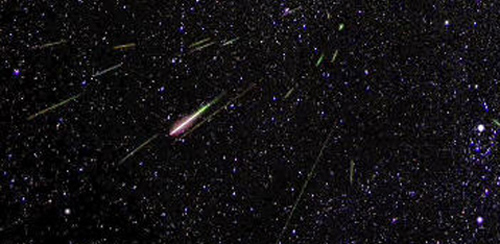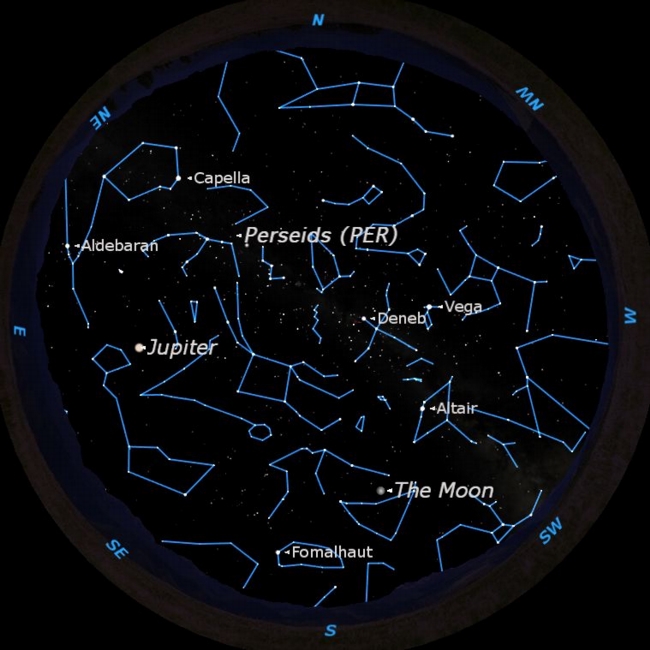Perseid Meteor Shower Competes With Full Moon on Friday

This week marks the annual return of the Perseid meteor shower, the most reliable meteor shower of the year, though the full moon may interfere with this year's display.
The Perseid meteor shower peaks this week in the overnight hours of Friday and Saturday (Aug. 12 and 13) just before the full moon hits its maximum brightness. If you're preparing to try to catch the light show, here are some meteor basics to get you started:
As the Earth travels in its orbit around the sun, it passes through various streams of interplanetary debris, known as meteoroids. Most of these are left in the wake of comets. Whenever a comet comes near the sun, it gets warmed and sheds material: gas and dust. The gas forms its characteristic tail, and the dust is left behind.
When the Earth passes through a trail of dust, the dust particles enter the Earth’s atmosphere at high speed, and heat it to incandescence. The rapid bright streaks that result are called meteors. [Amazing Perseid Meteor Shower Photos]
You can go out any night and observe meteors. Most of these are just random particles of interplanetary dust that the Earth happens to encounter, and are known as sporadic meteors.
When the Earth encounters a more concentrated patch of material, we get what is called a meteor shower. A few times in a century, we encounter a major field of meteoroids; the result is called a meteor storm.
It helps to think of these in terms of rainfall. Most of the time, there is no meteor rain, but at certain times, we experience a rain shower: a fine sprinkling of raindrops. On much rarer occasions, we get a full scale rain storm, with large quantities of meteors falling.
Breaking space news, the latest updates on rocket launches, skywatching events and more!
The Perseid meteor shower sky map available here shows where to look in the night sky to see this year's meteor shower.
Meteor showers: What to expect
Beginners in astronomy often have false expectations of what a meteor shower is like. They may have read accounts of the once-in-a lifetime meteor storms, where the sky is filled with falling meteors.
The reality is much less spectacular. Think of a meteor shower as the sprinkling of an April shower, rather than an August downpour.
Even though the Perseids are the largest meteor shower of the year, they often disappoint first time viewers. As with many things in astronomy, the key factors to the enjoyment of the Perseids are timing and patience.
Three things define a meteor shower: the time of its peak, the breadth of that peak, and the expected number of meteors per hour.
The Perseid shower is a winner on all three counts. It occurs in the second week of August, when nighttime temperatures are comfortable, it has a much broader peak than average, and it has one of the highest zenithal hourly rates of any meteor shower, 90. This means that if its radiant was directly overhead, the average observer under dark skies would see 90 meteors per hour.
Let’s back up and look at the term "radiant." The radiant of a meteor shower is defined as the apparent point in the sky from which the meteors in a shower appear to radiate.
Perseid meteor skywatching tips
The Perseids get their name because they originally appeared to radiate from a point in the constellation Perseus, though currently the radiant is in Cassiopeia.
When we are looking at the radiant of a meteor shower, we are looking up along the incoming path of debris from a particular object, usually a comet. In the case of the Perseids, this is Comet Swift-Tuttle. A periodic comet with a period of 130 years, this discovered by Lewis Swift and Horace Tuttle in 1862, and observed again on its return to the inner solar system in 1992.
It helps to think of the comet as a clump of concentrated material at one point in a long elliptical orbit, but with lesser amounts of material smeared along this orbit so that, every year when Earth passes through it, we encounter some of this debris.
Knowing the radiant and time and date of the peak (this year predicted for 2 a.m. EDT on the night of August 12 and13) lets us determine how to best observe the Perseids. Normally the best time would be after local midnight (1 a.m. Local Time) on the night of the peak; after midnight because we sweep up more meteoroids on the leading side of Earth as it circles the sun.
Full moon interference
The catch this year is that full moon occurs just one hour after the peak of the shower, so we will have a bright full moon flooding the sky with light all night.
We can improve our chances by observing a few nights before the peak of the shower this year. Remember, this shower has a very broad peak, so there are almost as many Perseids a night or two before maximum as at maximum.
The moon sets about 50 minutes earlier each night so that tonight (Aug. 10 and 11), for example, it sets at 4 a.m., so that we will have a short period between moonset and morning twilight which is also reasonably close to the peak of the meteors.
It is always best to seek out dark country skies when going meteor watching. Any meteor shower includes both bright and faint meteors, but there are generally far more faint meteors than bright ones, so moonlight or light pollution will drastically cut down the number of meteors you will see.
Another tip for meteor watchers is to allow at least 20 minutes for your eyes to become fully dark adapted. Dress warmly, even in summer.
A chaise longue or deck chair makes a comfortable viewing setup. Finally: patience. Meteors tend to come in bunches, with long dry periods in between. Count on spending at least an hour or two watching, if you want to be sure of catching many meteors.
Many people want to know where to look, specifically the location of the radiant. In fact, you want to look away from the radiant, as the longest and brightest meteors will be about 90 degrees away. The radiant is actually located now in the constellation Cassiopeia, not Perseus, with its characteristic "W" shape. Keep the bright moon at your back and look mainly to the northwest, below the summer triangle of Vega, Deneb, and Altair.
Good luck and clear skies!
Editor's note: If you snap an amazing photo of a Perseid meteor this year and would like to share it with SPACE.com for a possible story or gallery, please contact managing editor Tariq Malik at: tmalik@space.com.
This article was provided to SPACE.com by Starry Night Education, the leader in space science curriculum solutions. Follow Starry Night on Twitter @StarryNightEdu.

Geoff Gaherty was Space.com's Night Sky columnist and in partnership with Starry Night software and a dedicated amateur astronomer who sought to share the wonders of the night sky with the world. Based in Canada, Geoff studied mathematics and physics at McGill University and earned a Ph.D. in anthropology from the University of Toronto, all while pursuing a passion for the night sky and serving as an astronomy communicator. He credited a partial solar eclipse observed in 1946 (at age 5) and his 1957 sighting of the Comet Arend-Roland as a teenager for sparking his interest in amateur astronomy. In 2008, Geoff won the Chant Medal from the Royal Astronomical Society of Canada, an award given to a Canadian amateur astronomer in recognition of their lifetime achievements. Sadly, Geoff passed away July 7, 2016 due to complications from a kidney transplant, but his legacy continues at Starry Night.

